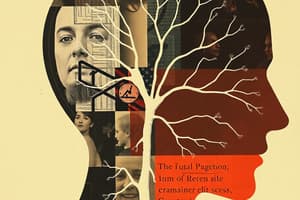Podcast
Questions and Answers
What is the primary structural unit of the nervous system?
What is the primary structural unit of the nervous system?
Which component is NOT part of a reflex arc?
Which component is NOT part of a reflex arc?
What characterizes a threshold stimulus?
What characterizes a threshold stimulus?
The autonomic nervous system is primarily responsible for which function?
The autonomic nervous system is primarily responsible for which function?
Signup and view all the answers
Which of the following represents a subthreshold stimulus?
Which of the following represents a subthreshold stimulus?
Signup and view all the answers
What type of changes occur in a nerve when it receives a stimulus?
What type of changes occur in a nerve when it receives a stimulus?
Signup and view all the answers
What primarily distinguishes sensory nerves from motor nerves?
What primarily distinguishes sensory nerves from motor nerves?
Signup and view all the answers
The central nervous system (CNS) includes which of the following structures?
The central nervous system (CNS) includes which of the following structures?
Signup and view all the answers
What type of conduction is associated with unmyelinated nerve fibers?
What type of conduction is associated with unmyelinated nerve fibers?
Signup and view all the answers
Which muscle types do not follow the all-or-none law?
Which muscle types do not follow the all-or-none law?
Signup and view all the answers
What occurs during the supernormal phase of nerve excitability?
What occurs during the supernormal phase of nerve excitability?
Signup and view all the answers
What is the first step in the excitation-contraction coupling process of skeletal muscle?
What is the first step in the excitation-contraction coupling process of skeletal muscle?
Signup and view all the answers
What effect does ATP breakdown have during the propagation of a nerve impulse?
What effect does ATP breakdown have during the propagation of a nerve impulse?
Signup and view all the answers
What is produced when subthreshold stimuli are applied successively?
What is produced when subthreshold stimuli are applied successively?
Signup and view all the answers
Which phase indicates that stronger stimuli are required to excite the nerve?
Which phase indicates that stronger stimuli are required to excite the nerve?
Signup and view all the answers
During muscle contraction, what happens after calcium ions are released?
During muscle contraction, what happens after calcium ions are released?
Signup and view all the answers
Study Notes
Nervous System - Part 1: Excitable Tissues
- The neuron is the basic structural and functional unit of the nervous system.
- Reflex action occurs via a reflex arc (receptor, afferent pathway, integrating center, efferent pathway, and effector).
- Anatomical classification of the nervous system includes the central nervous system (CNS) and the peripheral nervous system (PNS).
- CNS includes the brain (cerebrum, subcortical centers, cerebellum, brain stem) and spinal cord (31 segments with horns and columns).
- PNS includes 12 pairs of cranial nerves and 31 pairs of spinal nerves.
- Physiological classification includes sensory (transmitting sensations from receptors) and motor (transmitting orders from motor centers to effector organs) parts.
- Somatic (voluntary movements) and visceral (automatic control) are subdivisions of motor functions.
- Special senses are also part of the sensory classification.
- Nerve properties include excitability and conductivity.
- Excitability: Nerves respond to various stimuli (electrical, chemical, mechanical, thermal). These stimuli can be subthreshold, threshold, or suprathreshold, with the threshold being the minimum intensity for a response.
- Conductivity: Generated nerve impulses are conducted along the nerve fiber, either through unmyelinated (sweeping) or myelinated (saltatory) conduction.
- All-or-none law: A nerve either responds maximally or not at all to a threshold stimulus, assuming other excitability factors remain constant. -Applies to single nerve fibers, single motor units, cardiac muscle, and unitary smooth muscle; not whole skeletal muscle, nerve trunks, or multiunit smooth muscle.
- Summation: Subthreshold stimuli, if applied successively within a short period, can sum to create an action potential.
- Adaptation: Nerve fibers quickly adapt to constant or gradually intensifying stimuli.
- Infatigability: Nerve fibers do not get fatigued with repeated stimulation.
Electrical Changes: Resting Membrane Potential
- Resting membrane potential (RMP) is the difference in electrical charge between the inner and outer surfaces of a cell membrane.
- RMP is typically around -70 mV, maintained by selective permeability and the sodium-potassium pump.
- Ion channels and molecular size affect ion diffusion across the membrane.
- The sodium-potassium pump actively transports 3 sodium ions out and 2 potassium ions in, maintaining unequal ion concentrations across the membrane. This contributes to the RMP.
- Electrical current stimulation can cause polarization or hyper-polarization.
- Action potentials involve depolarization, repolarization with and without after-potentials.
Neuromuscular Transmission and Skeletal Muscle Contraction
- The mechanism of neuromuscular transmission involves the release of acetylcholine (ACh) at the synapse, binding to receptors on the muscle cell membrane, and initiating an action potential.
- Depolarization of the muscle fiber initiates the contraction process.
- Calcium ions are released from the sarcoplasmic reticulum, initiating the cross-bridge cycling, sliding filament mechanism, and ultimately causing the muscle to contract.
Studying That Suits You
Use AI to generate personalized quizzes and flashcards to suit your learning preferences.
Related Documents
Description
Explore the foundational concepts of the nervous system in this quiz. Covering neuron structure, reflex actions, and the classification of the central and peripheral nervous systems, you'll deepen your understanding of how nervous tissues function as excitable elements. Test your knowledge on both anatomical and physiological classifications as well as nerve properties.





